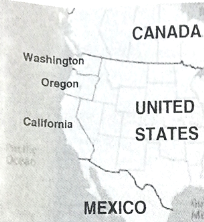题目内容
【题目】 A study has found that warmer waters off North America's West Coast caused many kinds of sea life to move farther north than ever before.

The study was a project of scientists from the University of California, Davis. The scientists examined waters off the coast of Northern California in the eastern Pacific Ocean. The researchers say they recognized a local of 67 species( 物种)between 2014 and 2016, during what was described as a "marine heat wave". Marine heatwaves were explained in the study as "period of extreme sea surface temperatures lasting for days to months". The 2014-2016 heatwave is thought to be the largest ever recorded. The warn water later moved south toward California.
The warmer water were partly a product of El Nio conditions during the same period, researcher noted. El Nio develops when winds off the coast of South America weaken. This enabled warm water in the western Pacific to move eastward. El Nio often causes ocean temperatures in the area to rise between 2 to 4 degrees Celsius, the study found.
The researchers reported that 37 of the 67 species they studied had never before been observed so far north as California. These creatures are native to an area hundreds of kilometers to the south, mainly around Baja California in Mexico. A few were even found north of California, off the state of Oregon. The northward travel of so many different sea creatures was considered "unprecedented"(史无前例的)by the researchers. Among the species found in the study were a meat-eating sea slug that hunts other sea slugs, a sea snail "butterfly" and purple-lined jellyfish. Another unexpected visitor was the pelagic red crab, which researchers said had only been found in areas off the coast of Mexico.
Scientists involved in the study believe the findings can provide valuable information for knowing future sea life reactions to warming oceans.
【1】What is a marine heat wave according to the passage?
A.An ocean with rough surface.
B.A wave with low temperatures.
C.A period of warmer ocean surface water.
D.A species living in extreme weather.
【2】What contributes to El Nio conditions?
A.Warmer waters.B.Weakened winds off South America.
C.Colder sea surface.D.Species moving northward.
【3】Why does the author mention the men-eat in sea lug in paragraph 4?
A.To point out that ocean environment becomes worse.
B.To suggest that sea creatures need separate living space.
C.To prove that many kinds of sea life can adapt to warmer waters.
D.To evidence that ocean temperature along California are higher than before.
【4】What can be inferred from the passage?
A.The heatwaves disturb the life of many sea creatures.
B.The increased temperature benefits many sea creatures.
C.Sea life reactions can be valuable to predict future heatwaves.
D.The heatwaves cause many unexpected visitors to move southward.
【答案】
【1】C
【2】B
【3】D
【4】A
【解析】
这是一篇说明文。短文说明了海洋热浪致美国大量海洋生物异常北迁。
【1】细节理解题。由第二段“Marine heatwaves were explained in the study as "period of extreme sea surface temperatures lasting for days to months”可知,这项研究将海洋热浪解释为“持续数天至数月的极端海面温度上升期。所以根据文章,海洋热浪是一段海洋表层水变暖的时期。故选C项。
【2】细节理解题。由第三段“El Nio develops when winds off the coast of South America weaken”可知,当南美洲海岸的风减弱时,厄尔尼诺现象就会发展。所以南美洲减弱的风促使了厄尔尼诺现象的产生。故选B项。
【3】推理判断题。由最后段“The researchers reported that 37 of the 67 species they studied had never before been observed so far north as California. Among the species found in the study were a meat-eating sea slug that hunts other sea slugs”可知,研究人员报告说,他们研究的67个物种中,有37个在加利福尼亚北部从未被观察。到在这项研究中发现的种类包括一种捕食其他海蛞蝓的食肉海蛞蝓。所以研究的67个物种中,有37个在加利福尼亚北部从未被观察,可知这些生物现在此地被发现而以前没有被发现是因为福尼亚沿岸的海洋温度比以前高。所以为什么作者在第四段中提到了食肉海蛞蝓就是为了证明加利福尼亚沿岸的海洋温度比以前高了。故选D项。
【4】推理判断题。通读全文尤其是第一段“A study has found that warmer waters off North America's West Coast caused many kinds of sea life to move farther north than ever before”可知,一项研究发现,北美洲西海岸温暖的海水导致许多种类的海洋生物比以往任何时候都向北方移动,所以海洋热浪致美国大量海洋生物异常北迁。这是一种被迫性地迁移。所以根据海洋生物的被迫迁移可以判断出,热浪扰乱了许多海洋生物的生活。故选A项。

